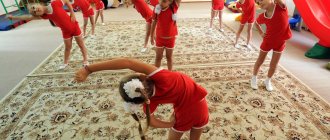Principles of introducing the Tatar language and culture in kindergartens of Tatarstan
Author: Akberova Gulshat Gadievna
Principles of introducing the Tatar language and culture in kindergartens of Tatarstan
The development of children’s native speech, mastery of the richness of their native language is one of the main elements of personality formation, mastering the developed values of national culture. They are closely related to mental, moral, aesthetic development and are a priority in language education and training of preschoolers. The global path of education is the promotion of a child to universal humanistic values through the child’s familiarization with his or her national or local culture. Only by rising above a narrow national understanding of the world do you begin to treat your native language more deeply and carefully. Bilingualism and multiculturalism do not hinder personal development: on the contrary, one language helps another to form, look at the world more broadly and understand it more deeply.
The work of preschool educational institutions towards the introduction of the national-regional component is complex and multifaceted. It requires mass comprehension, comprehensive discussion and analysis. The formation of a child’s personality is impossible either without attachment to one’s historical roots, or without counting on a special, unique future. It is the combination of these perspectives that shapes today’s work in preschool educational institutions (PEDs). People of different nationalities live in the Republic of Tatarstan. The authorities are working to resolve issues related to the implementation of state national policy aimed at preserving and developing national identity and preserving the cultural and historical heritage of the peoples of Tatarstan, and improving the education system as a whole. A lot is being done to develop the languages of the peoples of Tatarstan, for intercultural dialogue, and for the exchange of spiritual cultural values. Along with this, the republic is solving the problem of preserving the language of the indigenous nationality - Tatar, because The young Tatar generation, living both in the city and in the village, began to lose their native language and do not speak it with their children. According to the evidence of the families we interviewed with preschool children, parents would be glad for their children to know the Tatar language, but do not know what to do to preserve it. Often they do not have a sufficient number of special manuals and books in the Tatar language that could be used to teach preschool children in the family. Because of this, every family has to start work on speech development, as it were, all over again. The Tatar language is now taught in all schools and kindergartens. The Russian language is of great importance in intercultural communication. More and more Tatars of the new generation are studying foreign languages. Remarkable successes have been achieved by representatives of the Republic of Tatarstan at various international forums. All this leads to the fact that citizens of the republic realize the need for multilingualism. However, moving towards practical solutions at the individual family level still presents challenges.
At the same time, the native language can be called the main component of national culture; it is a conductor of oral folk art. By teaching children their native language in kindergarten, teachers solve the important task of instilling love, respect, and respect for their interest in their small homeland. Local history work with children is carried out in all preschool educational institutions of the Republic of Tatarstan, starting from early preschool age. Many kindergartens provide teaching of the Tatar language in various forms. The Ministry of Education and Science of the Republic of Tatarstan, governing bodies of public education of the republic, preschool educational institutions organize their work in accordance with the legislation on education of the Russian Federation and the Republic of Tatarstan. The main objectives of kindergartens with a local component are: providing citizens with the rights to receive preschool education in their native language; preservation and development of the national preschool education system, creation of conditions for the functioning of kindergartens with a priority in work on local history and teaching the native language; improving the quality of teaching children their native language; improving work on continuity in the field of teaching the native language; work on the creation of programs, recommendations, manuals for teaching the native language to preschool children; identifying positive work experience of preschool educational institutions and teaching staff in this area. A very important component is the normalization of the inclusion of elements of the Tatar language in everyday life: sentencing, refraining, turning to folklore, accompanying actions with adequate descriptions, repeated repetition (expanded and narrowed) of the main provisions of the story.
Introduction to the Tatar language should occur in a volume sufficient for normal entry into school life, ensuring, as far as possible, the child’s full stay in the children’s group, where teaching will take place in the Tatar language. If a family decides to send a child to a school with a national-cultural component of education, then the first priority should be preparation for school with all the components associated with this concept. Respect for oneself, one’s origins, the homeland of one’s ancestors, the desire to preserve and support one’s native language and culture should not conflict with receiving a full-fledged education. If one abandons one’s roots, one grows up to be a semilingual (not fluent in any language), socially dangerous, unable to control one’s behavior, or a person with a marginal lifestyle. Therefore, the task should be to educate a bilingual and bicultural person who knows and understands at least two languages and two cultures equally well. The implementation of the above tasks is carried out through various forms of work with teaching staff of preschool educational institutions, preschool children, their parents, together with public education authorities of districts and cities of the republic.
The national-regional component is established by the constituent entities of the Russian Federation represented by their government bodies. In preschool educational institutions, the national-regional component is introduced into practice in two ways:
The first way: by adding local (regional, national) material to the educational areas of the Program implemented in kindergarten, integrating the regional component into the educational process:
Introducing preschool children to nature: acquaintance with the flora and fauna of Tatarstan; with folk signs; classes, conversations, KVN, quizzes, excursions, observations, didactic games; herbarium collection; collections; experimental work.
In visual arts classes: information about the fine arts of Tatarstan: about ornaments and decors; about the creativity of artists in the form of classes, excursions to workshops, meetings with artists in kindergarten); viewing paintings, reproductions, viewing slides, postcards; visiting the Museum of Fine Arts, the National Museum; acquaintance with authentic examples of ornamental art.
In manual labor classes: elements of national carpet weaving; Tatar embroidery; applique on fabric; paper applique.
Musical activities: musical folklore, song art of Tatarstan, musical culture of Tatarstan: acquaintance with the work of composers of Tatarstan; holidays, entertainment, gatherings, folk festivals; familiarization with Tatar musical instruments, use of audio and video recordings, gramophone records, musical instruments, portraits of Tatar composers in the group.
Familiarization with the surrounding world. Excursions: 2nd junior group - around the kindergarten, around the territory of the kindergarten; middle group - excursions to familiarize yourself with the sights of the microdistrict; senior group - walking and bus tours around the city, going to the cinema, theater park, square, museum, etc.; preparatory group - excursions outside the city: airport, village, village. Conversations: “Where does a person live”, “The house in which we live”, “Streets of our microdistrict, city”, “My native city”, “What is the sweetest thing in the world”, “Small Motherland and Big Motherland”, “Tatarstan in our heart." Signs, symbols, flag, coat of arms, badges, stamps, postcards, slides.
Familiarization with the past of the native land: organization of an ethnographic corner (room); excursions; meetings with parents: gatherings, organizing a sweet evening with tasting of national dishes.
Theatrical activities: dramatization games; dramatization of Tatar folk tales, works of Tatar writers and poets; display of all types of theaters (shadow, flannel, spoon, puppet, linear, toy theater, tabletop, finger theater); design of mummer corners (items of Tatar costume) in all age groups; visiting theaters; meetings with theater artists, employees of television and radio companies, and philharmonic artists; organizing a theater studio in a kindergarten.
Physical education: national outdoor games; national sports holidays; entertainment.
Introduction to fiction: folklore: proverbs, sayings, riddles, tongue twisters, tongue twisters, chants, teasers, myths, legends of the Tatar people; thematic exhibitions dedicated to the work of a particular writer or poet; reading Tatar books, fairy tales; design of book corners; library organization; meetings with poets, writers; excursions to the National Library (department of Tatar literature).
The second way: through the development of a regional program based on the implemented federal one. Such programs exist; they all went through the Educational and Methodological Council, the expert council of the Ministry of Public Education of the Republic of Tatarstan.
While maintaining the network of preschool educational institutions working in this direction, it is necessary to simultaneously expand the variability and create a scientific and methodological base for each type of institution. Continuing to improve the conditions for their functioning in accordance with the legislation of the Russian Federation and the Republic of Tatarstan, scientists and practitioners in the commonwealth are publishing more modern manuals for teaching the Tatar language, based on innovative techniques. Conducting targeted work on preparing programs and manuals for teaching preschool children their native language on a deep scientific basis, they use the latest technologies in the education and training of preschoolers, the Internet, and electronic learning tools.
The experience of the best innovative teachers in local history and teaching children their native language is studied, summarized and disseminated, experience and teaching techniques are published and demonstrated. Through the media, the most interesting examples of conducting classes by teachers of national groups and preschool educational institutions are promoted, and specific examples of family and institutional bilingualism are shown. In cities, when distributing vouchers to preschool educational institutions, the desire of parents to send their children to groups where they study their native language is taken into account. The range of services offered is expanding. Conditions are identified that contribute to the successful socialization of children of different nationalities, the assimilation of moral values, the formation of the foundations of patriotism and citizenship through inclusion in broad social interaction, familiarization with the cultural traditions of their own and other peoples, and with world artistic values. All this is accompanied by a whole range of various measures, including psychological and pedagogical support for the development of interculturality and tolerance in various types of children's activities.
The work of preschool educational institutions implementing national-regional components in the educational process has had a significant impact on the growth of the quality of their activities in all areas. The priority in determining the quality of preschool education remains the requirements for psychological and pedagogical conditions: the educational program, the nature of the relationship between an adult and a child, and the development environment. At the same time, the key point remains the requirements for the teacher’s activities and his professionalism. There should be more coverage in the media about the benefits of bilingualism, and bilingualism should be made the norm for raising preschoolers in the republic. This should be accompanied by work with families to cultivate interest not only in the past of the national culture, but also in its future, in the modernization of the entire education system, taking into account local characteristics.
In modern conditions of social development, the Tatar language is becoming a mandatory component of education not only at school, but also in national preschool educational institutions. Earlier teaching of the Tatar language creates excellent opportunities to arouse interest in the linguistic and cultural diversity of the Republic of Tatarstan and Russia, respect for the language and the culture of the Tatar people, contributes to the development of communicative speech tact.
Issues related to teaching a second language to preschoolers are the subject of wide debate today, since early childhood (4 years) is considered by experts as the most favorable period for language acquisition (E.I. Negnevitskaya, V.S. Mukhina, N.D. Galskaya, Z.Ya. Futerman and others)
The main task of studying the Tatar language in preschool age is the formation of initial skills and practical knowledge of the Tatar language in oral form.
In the learning process, children must learn to perceive and understand Tatar speech by ear and speak Tatar within the limits of the topics available to them, learned words, grammatical forms, syntactic structures and simple examples of coherent speech.
The entire course of teaching the Tatar language is designed to help children develop communication skills in situations that are natural for preschool children.
Classes on teaching the Tatar language are an organic part of educational work carried out in kindergarten and actively contribute to solving the problems of moral, physical, labor and aesthetic education of preschool children.
Upon completion of training, children should:
- in listening: understand and fulfill the teacher’s requests related to conducting classes, organizing various forms of play and service activities in accordance with the topics of speech situations defined for each age, and also understand by ear the teacher’s speech in educational and play situations;
- in speaking: be able to respond to questions, formulate requests, address the teacher and your comrades within exemplary communication situations, and also be able to speak out in accordance with the game situation in the amount of 1-2 phrases, be able to use counting rhymes, be able to compose a simple story , know nursery rhymes, poems, songs.
A unique predisposition to speech, the plasticity of the natural mechanism of speech acquisition gives the child the opportunity, under appropriate conditions, to successfully master a second language.
The effectiveness of the Tatar language teaching process is determined by how consistently its basic principles are implemented:
— the entire course of teaching the Tatar language should be focused not only on the formation of practical skills and abilities, but also on a more complete realization of the educational development potential of the Tatar language. Therefore, already in the first year of study, children are offered material and tasks that contribute to the development of imagination and the development of skills culture;
— in the process of learning the Tatar language, it is important to teach the child to empathize, pity, sympathize, understand, help. Therefore, in many situations modeled using this manual, children should, for example, help fairy-tale characters, each other, i.e. they are placed in conditions of choosing positive moral action;
— the process of teaching the Tatar language in kindergarten is characterized by a communicative orientation. Strengthening the communicative focus of training is carried out through the introduction of fairy-tale characters and the use of role-playing games.
It should be taken into account: the more active and meaningful the children’s activity with the memorized material, the higher their involuntary memorization of this material will be. What is interesting is remembered better. Therefore, the task of managing children’s involuntary memory includes the task of expanding children’s interests and cultivating their curiosity. Interest is not only a condition for the successful performance of work, but also arises in the process of its implementation. In cases where the active activity of children is aimed at solving various cognitive and speech problems, favorable conditions are created for children to experience the joy of learning.
The teacher’s task is to do everything possible to interest the child and support him throughout all years of education, through the use of the natural environment and a variety of communicative tasks. The process of teaching the Tatar language will be effective if it is built taking into account the age characteristics of children.
comments powered by HyperComments







